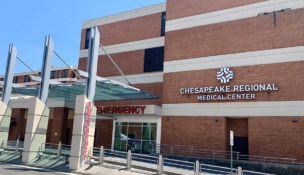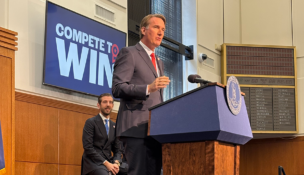Rising above
Cities plan to combat sea-level rise, but is it enough?
Sydney Lake //April 30, 2020//
Sea-level rise is happening faster than ever in Hampton Roads, experts say, up to an inch every four years. And if that doesn’t sound like a big deal, the Virginia Institute of Marine Science said in a February 2020 report that coastal waters could rise by more than a foot and a half by 2050.
Second only to New Orleans in flooding risk due to sea-level rise, according to the National Oceanic and Atmospheric Administration’s Office for Coastal Management, the Hampton Roads region is making strides toward safeguarding its land, although some larger localities are confronting the problem with bolder and more expensive solutions than smaller, rural localities can afford.
Buildings, roads and railways in areas already prone toward flooding will be increasingly impacted in coming decades — including the movement of freight into and out of the Port of Virginia — said retired U.S. Navy Rear Admiral Ann C. Phillips in a January speech to the Virginia Bar Association in Williamsburg.
In a region with a water-based economy, critical transportation infrastructure will be compromised by this environmental shift, she said, including recurring flooding, high winds, intense rainfalls and other factors.
NOAA predicts that three feet of sea-level rise could inundate 162 to 877 miles of the region’s roads, impacting up to 176,000 residents. It would also deliver a blow to military bases and the maritime industry.
“Much like the region’s federal facilities,” said Phillips, a special assistant to Gov. Ralph Northam for coastal adaptation and protection, the Port of Virginia’s “future resilience is inextricably linked to that of the surrounding cities and other localities that support and provide its critical utilities, transportation, logistics and supply chain infrastructure.”
This comes as no surprise to John Reinhart, CEO and executive director of the Virginia Port Authority, which oversees the port’s Hampton Roads terminals.
“When we started all of our implementation of our infrastructure, we looked at the sea-level rise effects, and we did raise our substations at [Norfolk International Terminals] to take into account some sea-level rise,” Reinhart says.
In December 2019, Virginia Beach made waves by issuing a policy report on sea-level rise that acknowledges it currently has no system or review process for retrofitting or maintaining roads to protect them against flooding. The city has devoted $3.8 million since 2015 — including an $844,000 grant from NOAA — to study flooding and identifying measures to reduce risk.
In January, the city’s public works engineering department, with consulting firm Dewberry, presented an extensive study to protect its watersheds and flood-prone property. The city’s even considering buying out or elevating properties that often flood — spending previously covered by the Federal Emergency Management Agency (FEMA) — but using $1.5 million in city funds initially and then $500,000 annually. The question is whether the city can still afford to do this following the economic devastation from COVID-19.
A regional approach has long been the argument of many experts. The Hampton Roads Planning District Commission recommended in October 2018 that localities need to work together to best prepare for sea-level rise.
“Large regional solutions, like floodgates, pump stations and seawalls, will likely be deployed to protect economically important and defense-related infrastructure,” Mark W. Luckenbach, associate dean of research at William & Mary’s Virginia Institute of Marine Science, said during the VBA conference.
Organizations like the Norfolk-based nonprofit RISE are working to fund development projects to address flood management, reestablishing critical utilities, and urban mobility as it relates to sea-level rise in Hampton Roads, awarding up to $250,000 per proposal. It’s seeking applications through June 1.
Kyle Spencer, the city of Norfolk’s deputy resilience officer, says “creative, smaller-scale, affordable solutions” are welcome, even while the region considers larger programs. “Big infrastructure projects take years and billions of dollars to implement.”


















